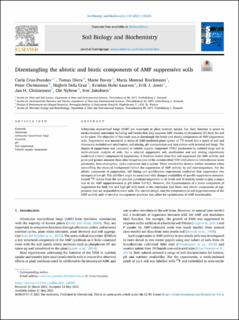| dc.contributor.author | Cruz-Paredes, Carla | |
| dc.contributor.author | Diera, Tomas | |
| dc.contributor.author | Davey, Marie Louise | |
| dc.contributor.author | Rieckmann, Maria Monrad | |
| dc.contributor.author | Christensen, Peter | |
| dc.contributor.author | Cruz, Majbrit Dela | |
| dc.contributor.author | Laursen, Kristian Holst | |
| dc.contributor.author | Joner, Erik | |
| dc.contributor.author | Christensen, Jan H. | |
| dc.contributor.author | Nybroe, Ole | |
| dc.contributor.author | Jakobsen, Iver | |
| dc.date.accessioned | 2021-10-14T11:50:50Z | |
| dc.date.available | 2021-10-14T11:50:50Z | |
| dc.date.created | 2021-05-24T22:17:15Z | |
| dc.date.issued | 2021-05-21 | |
| dc.identifier.citation | Soil Biology and Biochemistry. 2021, 159 . | en_US |
| dc.identifier.issn | 0038-0717 | |
| dc.identifier.uri | https://hdl.handle.net/11250/2823025 | |
| dc.description.abstract | Arbuscular mycorrhizal fungi (AMF) are important in plant nutrient uptake, but their function is prone to environmental constraints including soil factors that may suppress AMF transfer of phosphorus (P) from the soil to the plant. The objective of this study was to disentangle the biotic and abiotic components of AMF-suppressive soils. Suppression was measured in terms of AMF-mediated plant uptake of 33P mixed into a patch of soil and treatments included soil sterilization, soil mixing, pH manipulation and inoculation with isolated soil fungi. The degree of suppression was compared to volatile organic compound (VOC) production by isolated fungi and to multi-element analysis of soils. For a selected suppressive soil, sterilization and soil mixing experiments confirmed a biotic component of suppression. A Fusarium isolate from that soil suppressed the AMF activity and produced greater amounts than other fungal isolates of the antimicrobial VOC trichodiene (a trichothecene toxin precursor), beta-chamigrene, alpha-cuprenene and p-xylene. These metabolites deserve further attention when unravelling the chemical background behind the suppression of AMF activity by soil microorganisms. For the abiotic component of suppression, soil liming and acidification experiments confirmed that suppression was strongest at low pH. The pH effect might be associated with changed availability of specific suppressive elements. Indeed 33P uptake from the soil patches correlated negatively to Al levels and Al toxicity seems to play a major role in the AMF suppressiveness at pH below 5.0–5.2. However, the documentation of a biotic component of suppression for both low and high pH soils leads to the conclusion that biotic and abiotic components of suppression may act in parallel in some soils. The current insight into the components of soil suppressiveness of the AMF activity aids to develop management practices that allow for optimization of AMF functionality. | en_US |
| dc.language.iso | eng | en_US |
| dc.publisher | Elsevier Ltd. | en_US |
| dc.rights | Navngivelse 4.0 Internasjonal | * |
| dc.rights.uri | http://creativecommons.org/licenses/by/4.0/deed.no | * |
| dc.title | Disentangling the abiotic and biotic components of AMF suppressive soils | en_US |
| dc.type | Peer reviewed | en_US |
| dc.type | Journal article | en_US |
| dc.description.version | publishedVersion | en_US |
| dc.rights.holder | © 2021 The Author(s) | en_US |
| dc.source.pagenumber | 11 | en_US |
| dc.source.volume | 159 | en_US |
| dc.source.journal | Soil Biology and Biochemistry | en_US |
| dc.identifier.doi | 10.1016/j.soilbio.2021.108305 | |
| dc.identifier.cristin | 1911554 | |
| dc.source.articlenumber | 108305 | en_US |
| cristin.ispublished | true | |
| cristin.fulltext | original | |
| cristin.qualitycode | 2 | |

